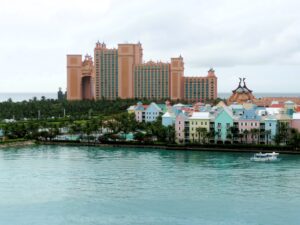
| Objective: Learn to SCUBA dive in the Bahamas and get your PADI certification Where: Nassau, New Providence Island; Paradise Island; The Bahamas Certification: 3 days classroom, 1 pool dive, 4 open water dives |
Here’s why you should learn to SCUBA dive in the Bahamas. The coral reefs are teeming with lifeforms of fancy shapes and fluorescent colors. The water is crystal clear and so warm that you don’t need a wetsuit. The conditions are so good that the next few dive sites will probably pale in comparison.
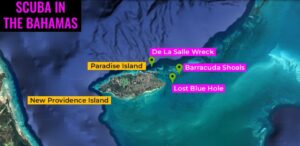
Nassau was once the Republic of Pirates. While pastel houses have replaced this colorful legacy, you can still seek adventure under the sea. At Nassau in New Providence Island, there are many dive operators where you can get your PADI certification. You will need 3-4 days. This includes knowledge development in a classroom setting. The instructors will teach you about how pressure increases the deeper you go and essential safety measures. You will also develop your skills with a couple half days in a pool at Paradise Island. A dive boat will take you offshore for four open water dives over two separate days. Just remember that before flying, you must wait 12 hours for single dives and 18 hours for multiple dives.
| Open Water Dives: 1-2: Wreck of the De La Salle: 20 feet, 40 minutes; 20 feet, 10 minutes 3: Lost Blue Hole: 52 feet, 32 minutes 4: Barracuda Reef: 28 feet, 25 minutes |

DIVES #1-2: WRECK OF THE DE LA SALLE
Gear Check
My very first dives in the open water is 20 minutes from the Nassau harbor. The dive boat stops next to a small island and drops anchor. After putting on an oxygen tank, mask, and flippers, I waddle to the stern. With a regulator in my mouth, I hold the mask to my face. Then, I extend my left leg off the edge and take a giant stride entry into the sea. While floating at the surface, my fingers form the OK signal to indicate to the instructor that I am fine. Thanks to the Gulf Stream, warm water flows around the Bahamas and provides a favorable climate for the coral reef.

Deflating the Buoyancy Control Device (BCD) makes you sink to the sea floor along the anchor line. Every few feet, you pinch your nose and blow to equalize the air pressure in the ear canals.
Putting New Skills to Work
The dive instructor has some exams to test what I have learned over the past few days. This includes removing and replacing the regulator and mask underwater. I also demonstrate how to tow a tired diver back to the boat. After performing a buddy breathing ascent, I swim above the final resting place of the De La Salle. During WWII, a U-boat sank the old cargo freighter, which is now an artificial reef.
Feeding the Fish
The best part of the dive is feeding the fish. My instructor rips a hole in a plastic bag of food and hands it to me. I am immediately swarmed by a school of fish from all directions. The fish don’t care I am in their way and bump into me on the way to their meal. They start chomping at the bag and food starts floating all over the place. More fish arrive and take stabs at the food.
After this dive, we head back to Nassau. The instructors are having a blast and they jump in the water from the back of the boat. While skimming behind the boat on their bellies, one of them gets up and stands on the other’s back.
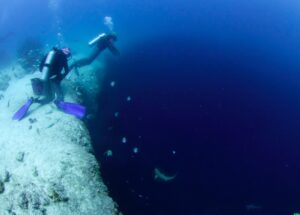
LOST BLUE HOLE (DIVE #3)
During the last Ice Age, caves formed across the Bahamas. The next day’s first dive is at one of these flooded pools – the Lost Blue Hole. With a regulator in my mouth, I hold the mask to my face. Then, I extend my left leg as far as possible and take a giant stride entry into the sea. As I get closer, it seems as if I am about to plunge into a dark pit. We follow a spiraling route around the edge of the hole. The blue hole is scary. Who knows what lurks down in the deep abyss?

After swimming up above the lip of the hole, we see a nurse shark 10′ above and on our right. At the sea floor, a spiny lionfish struts its feathery long fins.
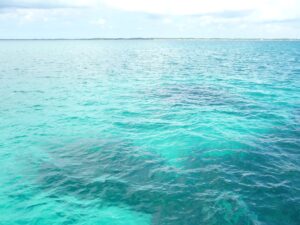
BARRACUDA SHOALS (DIVE #4)
Navigation Clinic
The next dive of Day 2 is at Barracuda Shoals. The objective is to practice underwater compass navigation. You need to set a course using the compass’s lubber line and perform 30 kicks. Then you must turn around and adjust the compass dial to ‘S’ and perform another 30 kicks. After looking up, I am back where I started, right next to the instructor. On the other hand, surface compass navigation is not as easy. I point the compass at Atlantis resort on Paradise Island, but when I return, I’m not close to the ship. I repeat this a couple times and figure out that the waves have slightly pushed me off course.

Life Aquatic
During my free swim around the reef, I see all types of undersea life. The variety and range of colors are a sight to behold. I can’t remember all of the colors and patterns I have seen because there is so much to take in. The yellow tail snapper has a yellow stripe along its body that leads to a, you guessed it, yellow tail. The blue tang has a yellow triangle on its tail and is as blue as a squished blueberry.

Skinny white fish and multiple schools of fish swim right past me. A delicate fan coral flops around in syncopation with the gentle underwater currents. The coral reef grows in all directions. I swim above, move below, and wriggle through the center of the gaps throughout the coral. Hills of purple brain coral look like giant brains.
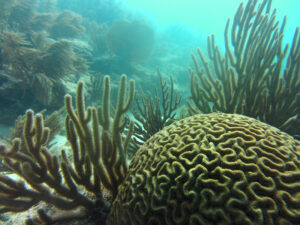
Discovering New Worlds
It feels like I am flying, in slow motion, through a crayon box-colored gulch of craggy coral nooks and crannies. This otherworldly ravine has coral shaped like trees, plants, cliffs, and boulders. With all this gear on my back, it’s fun to imagine being an astronaut exploring a liquid filled planet.
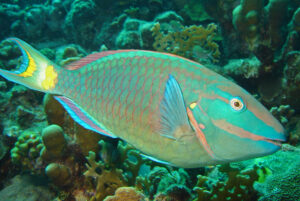
The star of the show is the parrotfish. The vibrantly colored parrotfish is a refugee from the Eighties. Its radical fluorescent colors and gnarly patterns would have totally fit in perfectly, dude.
I look up and see a group of air bubbles exhaled through the regulator. The bubbles float to the top and I follow closely behind. My head pops up above the surface of the water and that’s a wrap for this adventure.
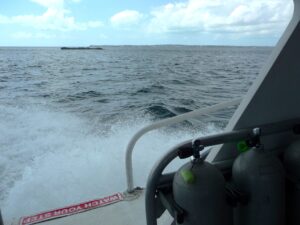
KEEP DIVING!
Dive the Great Barrier Reef and explore the massive ecosystem of 2,900 reefs.